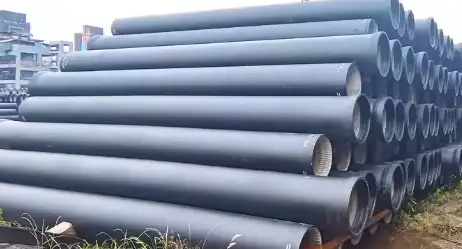Understanding the cost of a 12-inch ductile iron pipe is essential for planning infrastructure projects, particularly in water and wastewater systems. Ductile iron pipes are favored for their strength, durability, and versatility. This article provides an in-depth analysis of the factors influencing the cost of 12-inch ductile iron pipes, compares them with other materials, and offers practical insights for procurement and installation.

1. Factors Influencing the Cost of 12-Inch Ductile Iron Pipes
Several factors contribute to the pricing of ductile iron pipes:
a. Pipe Diameter and Wall Thickness
Larger diameters and thicker walls require more material and manufacturing processes, increasing the cost.
b. Pressure Class and Thickness Class
Higher pressure and thickness classes demand more robust materials and construction, leading to higher prices.
c. Coatings and Linings
Additional coatings, such as cement lining or epoxy, enhance corrosion resistance but add to the overall cost.
d. Joint Type
The type of joint, such as Tyton or mechanical joints, affects both installation ease and cost.
e. Quantity and Ordering Terms
Bulk purchases and long-term contracts can lead to discounts, whereas smaller orders may incur higher per-unit costs.
2. Price Estimates for 12-Inch Ductile Iron Pipes
Based on recent data, the cost of a 12-inch ductile iron pipe varies:
-
Fairfax Water (Class 52, Zinc Lined): $40.31 per foot
-
Louisville Water Company (Class 52, Zinc Lined): $52.63 per foot
-
City of Tulsa (Push-On Joint): $58.75 per foot
-
A. Louis Supply (Class 52, Tyton Joint): $99.50 per foot
These prices reflect variations in joint types, coatings, and supplier pricing strategies.
3. Comparison with Other Pipe Materials
| Pipe Material | 12″ Diameter Cost (per foot) | Durability | Cost | Common Applications |
|---|---|---|---|---|
| Ductile Iron | $40.31 – $99.50 | High | Moderate | Water and wastewater systems |
| Cast Iron | $35.00 – $60.00 | Moderate | Low | Older infrastructure systems |
| Steel | $25.00 – $50.00 | High | High | Industrial applications |
| PVC (Pressure Rated) | $15.00 – $30.00 | Low | Low | Residential water systems |
Ductile iron pipes offer a balance between cost and performance, making them suitable for various applications.
4. Practical Considerations for Purchasing and Installation
a. Supplier Selection
Choosing reputable suppliers ensures quality and reliability. Consider factors such as delivery times, customer service, and warranty offerings.
b. Transportation and Handling
Due to their weight, transporting ductile iron pipes requires specialized equipment. Ensure that the supplier offers delivery options that meet your project’s needs.
c. Installation Costs
Installation costs can vary based on location, labor rates, and site conditions. It’s essential to factor in these costs when budgeting for the project.
d. Maintenance and Longevity
Ductile iron pipes are known for their durability and low maintenance requirements, leading to cost savings over the pipe’s lifespan.
5. Frequently Asked Questions (FAQs)
1. Why does the cost of a 12-inch ductile iron pipe vary between suppliers?
The cost differences arise from factors such as joint types, coatings, pressure classes, and supplier pricing strategies. Additionally, regional market conditions and transportation costs can influence pricing.
2. How can I reduce the cost of purchasing ductile iron pipes?
Consider bulk purchasing, long-term contracts, and exploring different suppliers to find competitive pricing. Additionally, evaluating alternative joint types or coatings may offer cost savings without compromising quality.
3. What are the advantages of using ductile iron pipes over other materials?
Ductile iron pipes offer high strength, resistance to corrosion, and longevity, making them suitable for high-pressure applications. They also have a proven track record in water and wastewater systems.
4. Are there any hidden costs associated with ductile iron pipes?
Potential hidden costs include transportation fees, installation expenses, and maintenance over the pipe’s lifespan. It’s essential to account for these factors when budgeting for the project.
5. How do environmental factors affect the cost of ductile iron pipes?
Environmental conditions, such as soil corrosivity and groundwater chemistry, can influence the choice of coatings and linings, impacting the overall cost. Additionally, transportation costs may vary based on geographic location.
6. What is the typical lifespan of a ductile iron pipe?
With proper installation and maintenance, ductile iron pipes can last 50 to 100 years, offering long-term cost savings and reliability.
Conclusion
The cost of a 12-inch ductile iron pipe varies based on several factors, including joint type, coatings, and supplier pricing strategies. By understanding these factors and considering practical aspects such as transportation and installation, you can make informed decisions that align with your project’s budget and requirements.
References:
- Ductile Iron Pipe – Wikipedia
- AWWA C151 Standard for Ductile Iron Pipe – American Water Works Association
- Construction Material Costs and Factors – Industry Insights
- Water Pipes and Corrosion Control – U.S. Environmental Protection Agency
- OSHA Safety Standards for Handling and Installation of Pipes – U.S. Occupational Safety and Health Administration

